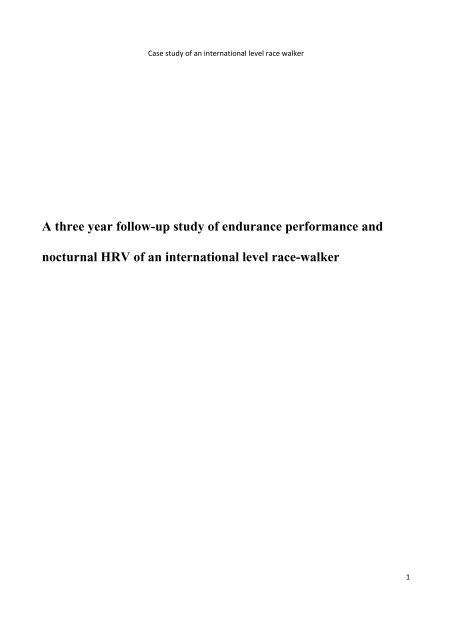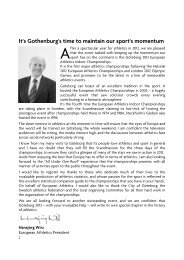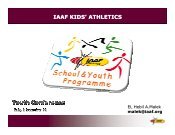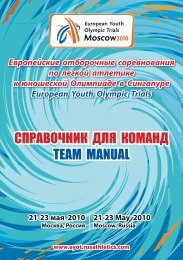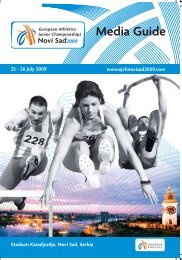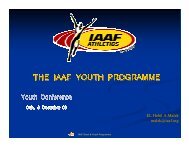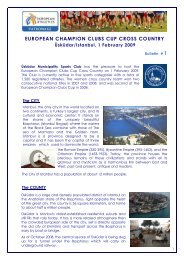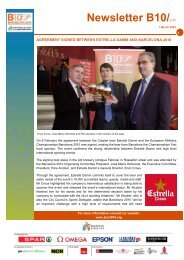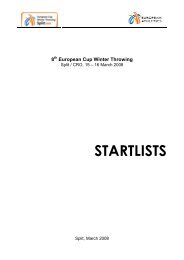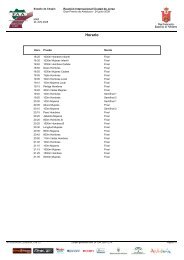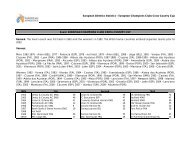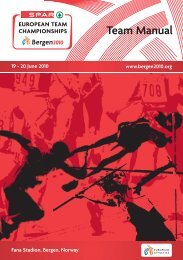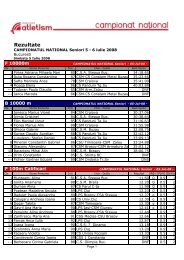A three year follow-up study of endurance performance and ...
A three year follow-up study of endurance performance and ...
A three year follow-up study of endurance performance and ...
Create successful ePaper yourself
Turn your PDF publications into a flip-book with our unique Google optimized e-Paper software.
Case <strong>study</strong> <strong>of</strong> an international level race walker<br />
A <strong>three</strong> <strong>year</strong> <strong>follow</strong>-<strong>up</strong> <strong>study</strong> <strong>of</strong> <strong>endurance</strong> <strong>performance</strong> <strong>and</strong><br />
nocturnal HRV <strong>of</strong> an international level race-walker<br />
1
Introduction<br />
Case <strong>study</strong> <strong>of</strong> an international level race walker<br />
Endurance <strong>performance</strong> is known to be determined by the capacity to transport <strong>and</strong> utilize oxygen, economy,<br />
neuromuscular characteristics, <strong>and</strong> muscle power (Paavolainen et al. 1999). The highest level <strong>of</strong> aerobic<br />
metabolism is the maximal oxygen <strong>up</strong>take (VO2max) <strong>and</strong> the VO2max <strong>of</strong> Olympic level <strong>endurance</strong> athletes seem to<br />
be between 70 <strong>and</strong> 85 ml·kg -1 ·min -1 . During <strong>endurance</strong> race most <strong>of</strong> the race is performed under the speed<br />
associated to VO2max, for example a marathon race is run at approximately 75-85 % <strong>of</strong> VO2max (Joyner <strong>and</strong><br />
Coyle. 2008). After many <strong>year</strong>s <strong>of</strong> <strong>endurance</strong> training only minor improvements in VO2max can be attained, but<br />
<strong>endurance</strong> <strong>performance</strong> may still be increased by improving movement economy <strong>and</strong> lactate threshold (Jones<br />
1998).<br />
To improve physical <strong>performance</strong> capacity, hard training is essential, but what is hard training for one, may be<br />
easy for another person (Midgley et al. 2006). According to the overload principle the training session has to be<br />
hard enough to disturb the homeostasis <strong>of</strong> the bodily functions <strong>and</strong> the recovery time has to be good <strong>and</strong> long<br />
enough to allow an increase in the determinants <strong>of</strong> <strong>performance</strong>, i.e. the training effect. If the disturbance is<br />
small, no training effect will occur (Rusko 2003). On the other h<strong>and</strong>, if the training is too dem<strong>and</strong>ing for the<br />
athlete, overtraining syndrome may develop (Meeusen et al. 2006; Rusko 2003). It has been difficult to estimate<br />
this disturbance <strong>of</strong> homeostasis, but estimating autonomic modulation could be useful, since changes in<br />
autonomic modulation may last even hours after an exercise session has been stopped (Furlan et al. 1993).<br />
Autonomic nervous system activity can be estimated non-invasively with heart rate variability (HRV)<br />
measurements (Task Force 1996). Cumulative training effects on nocturnal HRV have been studied in <strong>endurance</strong><br />
athletes <strong>and</strong> sedentary people during different training periods (Hautala et al. 2001; Hynynen et al. 2007; Pichot<br />
et al. 2000; Pichot et al. 2002). Pichot et al. (2000) found progressive decrease <strong>of</strong> <strong>up</strong> to 40 % in nocturnal HRV<br />
during the hard training period, <strong>follow</strong>ed by rebound during the relative resting week in middle-distance runners<br />
during their usual training cycle. Decrement in nocturnal HRV after an overreaching period has also been<br />
reported by Hynynen et al. (2007) in international level cross-country skiers. Recently, it was shown that also<br />
single <strong>endurance</strong> exercises can have remarkable effects on HRV during the <strong>follow</strong>ing night sleep (Hynynen et al.<br />
2010).<br />
Taken these together, the purpose <strong>of</strong> this case <strong>study</strong> was firstly to describe the annual changes in the <strong>endurance</strong><br />
<strong>performance</strong> characteristics <strong>of</strong> an international level <strong>endurance</strong> athlete, secondly to get information <strong>of</strong> training<br />
induced changes on autonomic modulation with the help <strong>of</strong> regular nocturnal HRV analysis <strong>and</strong> thirdly to <strong>study</strong><br />
how the changes in <strong>endurance</strong> <strong>performance</strong> characteristics <strong>and</strong> nocturnal HRV are related to the changes in the<br />
result <strong>of</strong> 20K <strong>and</strong> 50K race-walking. In addition, immediate feedback from all the measurements was given to<br />
help the athlete <strong>and</strong> his coach to adjust the training program if needed.<br />
Methods<br />
Analysis <strong>of</strong> test results<br />
The subject was tested on an indoor track (200 m) twice a <strong>year</strong> (1 st time in December-January <strong>and</strong> 2 nd time in<br />
March-April) <strong>and</strong> an average <strong>of</strong> these two tests was used as a representative value annually. This procedure was<br />
made to minimize the day to day variation in VO2 determination, <strong>and</strong> was similar to previous <strong>study</strong> <strong>of</strong> Jones<br />
(Jones. 1998). Preceding each test, the subject’s height <strong>and</strong> body mass was measured <strong>and</strong> the sum <strong>of</strong> four<br />
skinfolds was taken for body fat estimation (Durnin <strong>and</strong> Rahaman. 1967). The race-walking test consisted <strong>of</strong><br />
6×1000 m stages beginning from 3.05 m·s -1 (5 min 27 s per kilometer), <strong>and</strong> increased by 0.28 m·s -1 every stage<br />
until the sixth stage, which was a maximal time trial. Heart rate was measured with Suunto t6 heart rate monitor<br />
<strong>and</strong> respiratory gas exchange with Oxycon Mobile (Viasys Healthcare GmbH, Hoechberg, Germany)<br />
continuously, <strong>and</strong> 20 μl blood samples were taken for lactate analysis (Biosen S_line Lab+, EKF – diagnostic<br />
GmbH, Barleben, Germany) immediately after completing each stage. Respiratory gas exchange variables were<br />
determined as an average <strong>of</strong> the last minute each stage, except the VO2max, which was determined as the highest<br />
minute <strong>of</strong> the test. The energy cost was determined as the VO2 required to race-walk at 3.61 m·s -1 <strong>and</strong> at 3.89<br />
2
Case <strong>study</strong> <strong>of</strong> an international level race walker<br />
m·s -1 . The higher speed is associated with the average speed <strong>of</strong> the World Record in 50 km race-walking set by<br />
Denis Nizhegorodov in May 2008 (3:34:13).<br />
Analysis <strong>of</strong> HRV<br />
The subject recorded nocturnal RR-intervals with a Suunto t6 heart rate monitor (Suunto Ltd, Vantaa, Finl<strong>and</strong>)<br />
having a sampling frequency <strong>of</strong> 1000 Hz. RR-interval recordings were started before going to bed for sleep <strong>and</strong><br />
stopped after waking <strong>up</strong> in the morning. First 30 min after going to bed was excluded <strong>and</strong> the succeeding 4-hour<br />
section was analyzed. The 4 hour period was selected, because it has been used in previous studies (Hautala et al.<br />
2001; Hynynen et al. 2006; Hynynen et al. 2007; Pichot et al. 2000), <strong>and</strong> to compare HRV measurements, the<br />
selected periods should be <strong>of</strong> the same length (Task Force 1996). Nocturnal RR-intervals were collected<br />
throughout the <strong>year</strong>, <strong>and</strong> <strong>year</strong>ly recordings consisted <strong>of</strong> 125/2007, 235/2008, <strong>and</strong> 301/2009 night recordings (on<br />
average 220 nights/<strong>year</strong>). Results from the last 2 nights before the National Championship race <strong>of</strong> 20 km <strong>and</strong> the<br />
main race <strong>of</strong> the <strong>year</strong> (50 km in World Championships 2007 <strong>and</strong> 2009, Olympic Games 2008), <strong>and</strong> the first night<br />
after the races for every <strong>year</strong> are provided in this <strong>study</strong>. All the erroneous RR-intervals, like movement artifacts,<br />
were first carefully excluded using automated s<strong>of</strong>tware (Firstbeat Health, Firstbeat Technologies Ltd, Jyväskylä,<br />
Finl<strong>and</strong>) <strong>and</strong> visual inspection. The same s<strong>of</strong>tware was used to analyze the average HR <strong>and</strong> the <strong>follow</strong>ing HRV<br />
indices with frequency domain (Short-time Fourier transformation) methods: low frequency power (LFP; 0.04–<br />
0.15 Hz), high frequency power (HFP; 0.15–0.40 Hz), <strong>and</strong> total power (TP; LFP + HFP). In addition, the<br />
s<strong>of</strong>tware was used to calculate the ‘recovery index’ for the 4-hour sections. The recovery index is calculated<br />
from the RRI-data, <strong>and</strong> basically it increases when HRV is high <strong>and</strong> HR is low <strong>and</strong> vice versa (Kettunen <strong>and</strong><br />
Saalasti 2004). Pr<strong>of</strong>ile <strong>of</strong> HRV through the <strong>year</strong> is provided as a <strong>follow</strong>-<strong>up</strong> figure <strong>of</strong> the recovery index.<br />
Analysis <strong>of</strong> training<br />
The subject kept a training diary, including subjective description, amount <strong>and</strong> intensity <strong>of</strong> the training sessions,<br />
<strong>and</strong> perceived exertion <strong>of</strong> the training sessions. In this paper, sum <strong>of</strong> weekly training hours is used in order to<br />
describe the training.<br />
The <strong>study</strong> procedures <strong>and</strong> the right to withdrawal from any measurements at any time without repercussion were<br />
explained to the subject, <strong>and</strong> the subject gave his written informed consent before the beginning <strong>of</strong> the<br />
measurements. In addition, the subject gave permission to publish his results in this paper.<br />
Results<br />
In the beginning <strong>of</strong> this <strong>study</strong> the subject was 23 <strong>year</strong>s old. During the 3-<strong>year</strong> <strong>follow</strong>-<strong>up</strong> period there was only a<br />
little variation in the body mass <strong>and</strong> body fat (Table 1). Also VO2max seemed to be stabilized, or to slightly<br />
decrease in the last <strong>year</strong>. Although no changes in VO2max was observed, the maximal aerobic <strong>performance</strong>,<br />
measured as time trial on 1000 m, improved by 4 %.<br />
3
Case <strong>study</strong> <strong>of</strong> an international level race walker<br />
Table 1. Changes in various physical <strong>and</strong> physiological measures over <strong>three</strong> <strong>year</strong>s.<br />
2007 2008 2009<br />
Height (m) 1.88 1.88 1.88<br />
Body mass (kg) 73.2 74.5 73.2<br />
Body fat (%) 8.9 8.5 8.7<br />
VO2max<br />
(ml·kg -1 ·min -1 )<br />
Time trial <strong>of</strong> 1km<br />
(min:s)<br />
66.1 66.2 62.9<br />
3:47 3:45 3:39<br />
vmax (m·s -1 ) 4.38 4.42 4.55<br />
BLamax (mM·l -1 ) 10.6 10.7 11.3<br />
VO2max, maximal oxygen <strong>up</strong>take; vmax, average velocity <strong>of</strong> maximal time trial; BLamax, maximal blood lactate<br />
concentration after the time trial.<br />
The economy <strong>of</strong> race-walking improved, as seen in decreasing trend <strong>of</strong> cost <strong>of</strong> walking at submaximal speeds<br />
(Figure 1). Decrease in consumed oxygen per 1000 m was found to be 7.0 % at the higher speed <strong>and</strong> 2.6 % at<br />
slower speed (Figure 1). In addition, personal best times decreased steadily annually in 50K, but in 20K only<br />
minor changes were observed (Figure 2).<br />
Walking economy (mlO 2*kg ‐1 *1000m ‐1 )<br />
260<br />
250<br />
240<br />
230<br />
220<br />
210<br />
200<br />
2007 2008 2009<br />
Figure 1. Cost <strong>of</strong> walking at 3.61 m·s -1 <strong>and</strong> 3.89 m·s -1 annually.<br />
3.89 m/s<br />
3.61 m/s<br />
4
Change in "PB" in relation to <strong>year</strong> 2007<br />
Case <strong>study</strong> <strong>of</strong> an international level race walker<br />
Figure 2. Improvement in personal best times (PB) in 20 km <strong>and</strong> 50 km races from 2007 to 2009.<br />
The results from the national championship races <strong>of</strong> 20 km <strong>and</strong> from the international championship races <strong>of</strong> 50<br />
km are presented in Table 2. The results <strong>of</strong> the 50 km races were new personal best times every <strong>year</strong>, but only<br />
the result <strong>of</strong> the 2008 race on 20 km was a new personal best time (at that time).<br />
Table 2. Average heart rate <strong>and</strong> result <strong>of</strong> the national championship (20 km) <strong>and</strong> international championship (50<br />
km) races annually (2007-2009). One HR value is missing due to technical problems in recording the HR data.<br />
20 km<br />
50 km<br />
0.0 %<br />
‐0.5 %<br />
‐1.0 %<br />
‐1.5 %<br />
‐2.0 %<br />
‐2.5 %<br />
‐3.0 %<br />
‐3.5 %<br />
‐4.0 %<br />
‐4.5 %<br />
‐5.0 %<br />
2007 2008 2009<br />
2007 2008 2009<br />
Result (h:min:sec) 1:29:24 1:25:56 1:27:30<br />
Average HR - 186 172<br />
Result (h:min:sec) 3:58:22 3:52:25 3:47:36<br />
Average HR 165 168 169<br />
20 km<br />
50 km<br />
Table 3. Nocturnal HR <strong>and</strong> HRV before <strong>and</strong> after the national championship race (20 km) annually (2007 –<br />
2009). The RR-interval data after the race in 2009 was too erroneous to be analyzed.<br />
2007 2008 2009<br />
before after before after before after<br />
HRave (bpm) 55.8 62.7 49.5 64.7 51.1 -<br />
LFP (ms 2 ) 9820 8424 7622 6456 5889 -<br />
HFP (ms 2 ) 7281 3542 7393 3676 4104 -<br />
TP (ms 2 ) 17101 11966 15015 10132 9994 -<br />
Recovery index 162 109 196 101 165 -<br />
HRave, average heart rate; LFP, low frequency power; HFP, high frequency power; TP, total power.<br />
5
Case <strong>study</strong> <strong>of</strong> an international level race walker<br />
Table 4. Nocturnal HR <strong>and</strong> HRV before <strong>and</strong> after the 50 km competition annually (2007 – 2009).<br />
2007 2008 2009<br />
before after before after before after<br />
HRave (bpm) 48.2 60.2 48.0 58.7 45.8 54.3<br />
LFP (ms 2 ) 7361 6734 7160 8697 5237 8504<br />
HFP (ms 2 ) 8946 3582 9782 5387 5901 7359<br />
TP (ms 2 ) 16306 10316 16942 14084 11139 15862<br />
Recovery index 219 120 222 134 209 164<br />
HRave, average heart rate; LFP, low frequency power; HFP, high frequency power; TP, total power.<br />
The dynamics in the nocturnal autonomic modulation through the whole training <strong>year</strong> are provided using<br />
recovery index as shown in Figures 3-5. Recovery index seemed to <strong>follow</strong> an opposite trend in comparison to<br />
weekly training hours, as pointed out with the arrows in the Figure 5. The lowest values <strong>of</strong> the recovery index,<br />
reflecting the highest cumulated training stress in the end <strong>of</strong> hard training periods, were found to be less than 150<br />
(arbitrary units). If values less than 120 were found during the training season, they were associated to an<br />
infection, <strong>and</strong> in some cases, later a fewer. The additional stress <strong>of</strong> altitude on autonomic modulation was seen in<br />
lower values <strong>of</strong> recovery index, as highlighted in Figure 5. During competition season, values below 120 were<br />
sometimes found after a race, too (Table 3, Figures 3-5). In every <strong>year</strong>, a similar trend <strong>of</strong> increasing values <strong>of</strong> the<br />
recovery index was found during the last month preceding the main competition in the World Championships or<br />
the Olympic Games (Figure 6). It started from low values <strong>and</strong> ended <strong>up</strong> to values over 200 during the last week<br />
before the competition.<br />
Weekly training hours<br />
25<br />
20<br />
15<br />
10<br />
-<br />
5<br />
Weekly training<br />
Recovery index<br />
-270 -240 -210 -180 -150 -120 -90 -60 -30 0<br />
Figure 3. Recovery index through the training <strong>year</strong> 2007. Day 0 on the horizontal axis is the day <strong>of</strong> the main<br />
competition <strong>and</strong> the corresponding value <strong>of</strong> that day is from the very next night. The bar <strong>of</strong> the weekly training<br />
hours is located on Sundays.<br />
250<br />
200<br />
150<br />
100<br />
50<br />
0<br />
Recovery index<br />
6
Weekly training hours<br />
Case <strong>study</strong> <strong>of</strong> an international level race walker<br />
Figure 4. Recovery index through the training <strong>year</strong> 2008. Day 0 on the horizontal axis is the day <strong>of</strong> the main<br />
competition <strong>and</strong> the corresponding value <strong>of</strong> that day is from the very next night. The bar <strong>of</strong> the weekly training<br />
hours is located on Sundays.<br />
Weekly training hours<br />
25<br />
20<br />
15<br />
10<br />
-<br />
5<br />
25<br />
20<br />
15<br />
10<br />
-<br />
5<br />
-300 -270 -240 -210 -180 -150 -120 -90 -60 -30 0<br />
Altitude<br />
training<br />
camp<br />
Weekly training<br />
Recovery index<br />
Weekly training<br />
Recovery index<br />
-330 -300 -270 -240 -210 -180 -150 -120 -90 -60 -30 0<br />
Figure 5. Recovery index through the training <strong>year</strong> 2009. Day 0 on the horizontal axis is the day <strong>of</strong> the main<br />
competition <strong>and</strong> the corresponding value <strong>of</strong> that day is from the very next night. The bar <strong>of</strong> the weekly training<br />
hours is located on Sundays. Additional arrows show opposite but simultaneous trends in training amount <strong>and</strong><br />
recovery index.<br />
250<br />
200<br />
150<br />
100<br />
50<br />
-<br />
250<br />
200<br />
150<br />
100<br />
50<br />
0<br />
Recovery index<br />
Recovery index<br />
7
Case <strong>study</strong> <strong>of</strong> an international level race walker<br />
Figure 6. Recovery index based on nocturnal HR <strong>and</strong> HRV during the last 30 nights before the main<br />
competition.<br />
Discussion<br />
This <strong>study</strong> investigated the longitudinal changes in <strong>endurance</strong> <strong>performance</strong> characteristics <strong>and</strong> nocturnal HRV<br />
over a <strong>three</strong>-<strong>year</strong> period in an international level race walker. Simultaneously with a gradual improvement in the<br />
race-walking <strong>performance</strong>, there was a gradual improvement in walking economy, but practically no change in<br />
VO2max was found during the <strong>follow</strong>-<strong>up</strong> period. Nocturnal HRV was found to be related to the stress <strong>of</strong> training,<br />
but no changes in HRV was found to be related to race-walking <strong>performance</strong>.<br />
There was only a little variation in the body mass <strong>and</strong> body fat during the <strong>follow</strong>-<strong>up</strong> period. Although the<br />
maximal velocity in the 1000 m time trial improved 3.8%, there was no improvement in VO2max. Simultaneously,<br />
energy cost <strong>of</strong> submaximal race-walking improved by 4.8 % <strong>and</strong> the race-walking <strong>performance</strong> in the main<br />
event, 50 km race, by 4.5 %. The energy cost <strong>of</strong> race-walking seemed to be similar to previous <strong>study</strong> <strong>of</strong><br />
Brisswalter et al. (1998) even though the speed associated with the measurement was 1-2 km×h -1 higher in the<br />
present <strong>study</strong>. This finding <strong>of</strong> improved economy is in line with previous <strong>study</strong> <strong>of</strong> Jones (1998), where energy<br />
cost <strong>of</strong> running was found to decrease by 6.7 % with a simultaneous improvement <strong>of</strong> 2.6 % in the best time in<br />
3000 m race during the last <strong>three</strong> <strong>year</strong> period <strong>of</strong> the five-<strong>year</strong> <strong>follow</strong> <strong>up</strong> <strong>of</strong> a world class female runner (Jones<br />
1998). The association <strong>of</strong> improved running economy <strong>and</strong> race <strong>performance</strong> has been previously reported (Jones<br />
1998; Maughan 2000) <strong>and</strong> the findings <strong>of</strong> this <strong>study</strong> complement the knowledge <strong>of</strong> <strong>endurance</strong> <strong>performance</strong> from<br />
the race-walking point <strong>of</strong> view. The subject in Jones <strong>study</strong> (1998) was only 17 <strong>year</strong>s old at the beginning <strong>of</strong> the<br />
<strong>study</strong> <strong>and</strong> the physical growth <strong>and</strong> maturation may have complicated the interpretation <strong>of</strong> the results. However,<br />
the subject in the present <strong>study</strong> was 23 <strong>year</strong>s old in the beginning <strong>of</strong> this <strong>study</strong> suggesting that growth <strong>and</strong><br />
maturation had no effect on the improvement <strong>of</strong> the <strong>performance</strong>. As the top marathon runners have been<br />
reported to be on average close to 30 <strong>year</strong>s old (Maughan 2000), one might expect the subject <strong>of</strong> our <strong>study</strong> to<br />
further enhance his <strong>performance</strong> for a few <strong>year</strong>s. This development is s<strong>up</strong>posed to happen via further<br />
improvements in the economy <strong>of</strong> race-walking <strong>and</strong> the ability to sustain higher percentage <strong>of</strong> his VO2max for the<br />
time <strong>of</strong> approximately 3 h <strong>and</strong> 40 min.<br />
2007<br />
2008<br />
2009<br />
‐30 ‐25 ‐20 ‐15 ‐10 ‐5 0<br />
250<br />
230<br />
210<br />
190<br />
170<br />
150<br />
130<br />
110<br />
90<br />
Recovery index<br />
8
Case <strong>study</strong> <strong>of</strong> an international level race walker<br />
The main finding from the nocturnal HRV measurements was that after a hard training session or a race,<br />
simultaneous increase in HR <strong>and</strong> decrease in HRV was found, which resulted in decreased recovery index. Not<br />
only the single values <strong>of</strong> recovery index after a hard training session, but also the trends over longer periods<br />
seemed to <strong>follow</strong> the stress <strong>of</strong> training <strong>and</strong> the subsequent recovery periods. Both the nocturnal HR <strong>and</strong> HRV are<br />
mainly related to the activity <strong>of</strong> parasympathetic branch <strong>of</strong> the autonomic nervous system, as it dominates<br />
usually during rest (Task Force 1996). Typically the training induced changes after a single exercise session<br />
(Hynynen et al. 2010), <strong>and</strong> a training period (Pichot et al. 2000; Pichot et al. 2002), are smaller in nocturnal HR<br />
than in HRV. The novelty <strong>of</strong> the HRV analysis used in this <strong>study</strong> was the combination <strong>of</strong> HR <strong>and</strong> HRV<br />
variables, the recovery index. As only one index was used as a <strong>follow</strong>-<strong>up</strong> measurement, it was easier to give<br />
feedback to the athlete from the training induced changes in nocturnal autonomic modulation. This method<br />
simplified the issue in a practical way, even though the formulas behind the index are pro<strong>of</strong>ed behind the patent<br />
(Kettunen <strong>and</strong> Saalasti 2004).<br />
National Championship race on 20 km were held 3-4 weeks before the 50 km race every <strong>year</strong> <strong>and</strong> as the training<br />
program for the last month before the main race was very similar every <strong>year</strong>, it was also a “turning point” from<br />
training to taper. Interestingly, in 2008, nocturnal HRV analysis preceding the race showed high values when<br />
compared to HRV results in 2007 <strong>and</strong> 2009, where lower values <strong>of</strong> HRV suggested lower parasympathetic<br />
modulation than in 2008. This decrement in parasympathetic modulation may have been due to higher exertion<br />
from the preceding training periods <strong>and</strong> reflecting worse state <strong>of</strong> recovery. This interpretation <strong>of</strong> HRV results is<br />
further s<strong>up</strong>ported by the <strong>performance</strong> in the races, since in 2008 the result in the national championships was<br />
high <strong>and</strong> in relation to results in 2007 <strong>and</strong> 2009 races with time difference <strong>of</strong> 1.5 – 3.5 minutes in 20 km race.<br />
Also the effort in the 2009 race may have not been maximal, as seen in much lower average HR during that race<br />
in comparison to the 2008 race. During the final month preceding the 50 km race a reproducible ascending trend<br />
was found in nocturnal HRV measurements suggesting that the tapering phase was successful for the recovery <strong>of</strong><br />
the body. The recovery index rose every <strong>year</strong> to values <strong>of</strong> 210-220 during the last week before the race. Also the<br />
recovery index preceding the national championship race in 2008 was close to the values seen before the main<br />
event, <strong>and</strong> the result <strong>of</strong> that race was a new personal best. Based on the experience <strong>of</strong> <strong>three</strong> <strong>year</strong>s, for this<br />
individual athlete, recovery index value <strong>of</strong> approximately 200 or higher seems to be needed to be able to perform<br />
at high level.<br />
Previously, Kiviniemi et al. (2007) suggested, that HRV measurements in the morning may be used to tailor the<br />
individual training program in a very successful way. They advised the recreational athletes in their <strong>study</strong> to do<br />
high intensity training only if the morning HRV was high. If the HRV was low, lower intensity or rest was<br />
suggested for the athlete (Kiviniemi et al. 2007). Similarly, the athlete in this <strong>study</strong> has used the nocturnal HRV<br />
measurements to adjust the training schedule especially during the high altitude training camps (no specific<br />
results shown here). However, as the gro<strong>up</strong> <strong>of</strong> Kiviniemi (2007) collected the individual database for the<br />
morning HRV, also the findings <strong>of</strong> this <strong>study</strong> suggest that the determination <strong>of</strong> the individual window <strong>of</strong> normal<br />
variation <strong>of</strong> nocturnal HRV is needed to be able to interpret the results <strong>of</strong> the HRV measurements. It seems that<br />
one divergent result is not always a “bad sign”, but if several consecutive nocturnal HRV measurements show<br />
unexpected results, there is a reason for them. This reason may be related to overreaching or some infection /<br />
other medical problem, <strong>and</strong> sometimes the cause <strong>of</strong> stress reactions may come from outside the sport. In any<br />
case, in order to decrease the relationship between stress <strong>and</strong> recovery <strong>and</strong> improve the <strong>performance</strong>, the cause<br />
<strong>of</strong> stress must be removed. If the stress is prolonged, undesirable results may <strong>follow</strong>.<br />
In conclusion, this longitudinal <strong>study</strong> <strong>of</strong> an international level race-walker showed that <strong>performance</strong> increments<br />
in race times were associated to increments in the economy <strong>of</strong> race-walking, not to changes in VO2max. Nocturnal<br />
HRV was found to be associated to the training <strong>and</strong> racing induced stress <strong>and</strong> an individual variation in recovery<br />
index was provided. In order to perform at high level in a competition, race-walker needs to be in a recovered<br />
state <strong>and</strong> parasympathetic dominance should be shown in nocturnal HRV analysis in pre-competition nights.<br />
9
Recommendations<br />
Case <strong>study</strong> <strong>of</strong> an international level race walker<br />
Regular physiological testing gives important <strong>and</strong> valid information on the athlete, that can’t be found from the<br />
results <strong>of</strong> competitions. In addition, regular nocturnal HRV analysis can give online feedback whether the athlete<br />
is recovered or stressed. Based on the experiences <strong>of</strong> the athlete <strong>and</strong> his coach, the <strong>follow</strong>ing list <strong>of</strong> findings <strong>and</strong><br />
recommendations concerning HRV measurements is provided:<br />
- Regular HRV analysis is needed to be able to react soon enough to undesirable changes in athlete’s state<br />
<strong>of</strong> recovery.<br />
- Great help especially when the coach can’t be present in e.g. high altitude training camp.<br />
- The athlete will learn to analyze the effects <strong>of</strong> different issues to the readiness to train <strong>and</strong> compete.<br />
- Avoid “bad training days” by adjusting the training schedule according to the athlete’s feelings together<br />
with the results <strong>of</strong> HRV analysis.<br />
- Adjust the rhythm <strong>of</strong> training <strong>and</strong> rest individually with the help <strong>of</strong> HRV analysis, the common 3:1 is not<br />
the best for every athlete.<br />
References<br />
Brisswalter J, Fougeron B, Legros P (1998) Variability in energy cost <strong>and</strong> walking gait during race walking in<br />
competitive race walkers. Med Sci Sports Exerc 30:1451-1455<br />
Durnin JV, Rahaman MM (1967) The assessment <strong>of</strong> the amount <strong>of</strong> fat in the human body from measurements <strong>of</strong><br />
skinfold thickness. Br J Nutr 21:681-689<br />
Furlan R, Piazza S, Dell'Orto S et al (1993) Early <strong>and</strong> late effects <strong>of</strong> exercise <strong>and</strong> athletic training on neural<br />
mechanisms controlling heart rate. Cardiovasc Res 27:482-488<br />
Hautala A, Tulppo MP, Makikallio TH, Laukkanen R, Nissila S, Huikuri HV (2001) Changes in cardiac<br />
autonomic regulation after prolonged maximal exercise. Clin Physiol 21:238-245<br />
Hynynen E, Vesterinen V, Rusko H, Nummela A (2010) Effects <strong>of</strong> Moderate <strong>and</strong> Heavy Endurance Exercise on<br />
Nocturnal HRV. Int J Sports Med . doi:10.1055/s-0030-1249625<br />
Hynynen E, Nummela A, Rusko H, Hamalainen I, Jylhä R (2007) Effects <strong>of</strong> training on cardiac autonomic<br />
modulation during night sleep in cross country skiers. In: Linnamo V, Komi PV, Müller E (eds) Science in<br />
Nordic SkiingMeyer & Meyer Sport Ltd., UK<br />
Hynynen E, Uusitalo A, Konttinen N, Rusko H (2006) Heart rate variability during night sleep <strong>and</strong> after<br />
awakening in overtrained athletes. Med Sci Sports Exerc 38:313-317. doi:10.1249/01.mss.0000184631.27641.b5<br />
Jones AM (1998) A five <strong>year</strong> physiological case <strong>study</strong> <strong>of</strong> an Olympic runner. Br J Sports Med 32:39-43<br />
Joyner MJ, Coyle EF (2008) Endurance exercise <strong>performance</strong>: the physiology <strong>of</strong> champions. J Physiol 586:35-<br />
44. doi:10.1113/jphysiol.2007.143834<br />
Kettunen J, Saalasti S (2004) Procedure for detection <strong>of</strong> stress by segmentation <strong>and</strong> analyzing a heart beat signal.<br />
Kiviniemi AM, Hautala AJ, Kinnunen H, Tulppo MP (2007) Endurance training guided individually by daily<br />
heart rate variability measurements. Eur J Appl Physiol 101:743-751. doi:10.1007/s00421-007-0552-2<br />
10
Case <strong>study</strong> <strong>of</strong> an international level race walker<br />
Maughan RJ (2000) Physiology <strong>and</strong> biochemistry <strong>of</strong> middle distance <strong>and</strong> long distance running. In: Hawley JA<br />
(ed) Running. H<strong>and</strong>book <strong>of</strong> Sports Medicine <strong>and</strong> ScienceBlackwell Science, Malden, MA, USA<br />
Meeusen R, Duclos M, Gleeson M, Rietjens G, Steinacker J, Urhausen A (2006) Prevention, diagnosis <strong>and</strong><br />
treatment <strong>of</strong> the Overtraining Syndrome. ECSS Position Statement ‘Task Force’. European Journal <strong>of</strong> Sport<br />
Science 6:1-14<br />
Midgley AW, McNaughton LR, Wilkinson M (2006) Is there an optimal training intensity for enhancing the<br />
maximal oxygen <strong>up</strong>take <strong>of</strong> distance runners?: empirical research findings, current opinions, physiological<br />
rationale <strong>and</strong> practical recommendations. Sports Med 36:117-132<br />
Paavolainen LM, Nummela AT, Rusko HK (1999) Neuromuscular characteristics <strong>and</strong> muscle power as<br />
determinants <strong>of</strong> 5-km running <strong>performance</strong>. Med Sci Sports Exerc 31:124-130<br />
Pichot V, Busso T, Roche F et al (2002) Autonomic adaptations to intensive <strong>and</strong> overload training periods: a<br />
laboratory <strong>study</strong>. Med Sci Sports Exerc 34:1660-1666. doi:10.1249/01.MSS.0000035993.08625.31<br />
Pichot V, Roche F, Gaspoz JM et al (2000) Relation between heart rate variability <strong>and</strong> training load in middledistance<br />
runners. Med Sci Sports Exerc 32:1729-1736<br />
Rusko H (ed) (2003) Cross Country Skiing. Blackwell Science, Malden, MA, USA<br />
Task Force (1996) Heart rate variability: st<strong>and</strong>ards <strong>of</strong> measurement, physiological interpretation <strong>and</strong> clinical<br />
use.Task Force <strong>of</strong> the European Society <strong>of</strong> Cardiology <strong>and</strong> the North American Society <strong>of</strong> Pacing <strong>and</strong><br />
Electrophysiology. Circulation 93:1043-1065<br />
11


